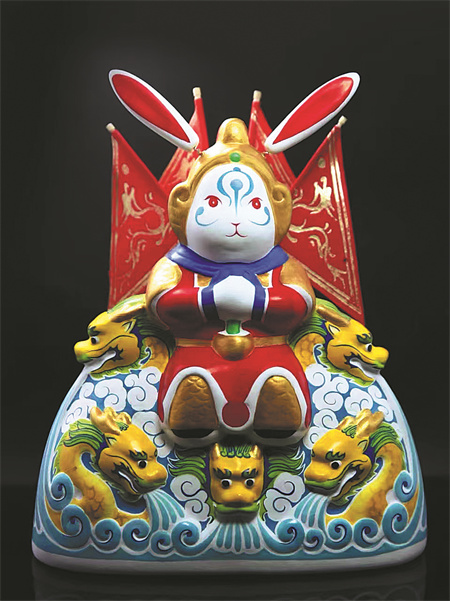

It usually takes him a week to finish one batch of statues, but sometimes it can cost more than a month.
Speaking of the difference between Tu'er Ye and Tuzi Wang, Yang says one main element is the ears — the design of those on the former are fixed, while the ears of the latter are linked with spring and the color is a bit different.
The second difference is that Tu'er Ye's face has no painting while Tuzi Wang's face does, Yang says, adding that the traditional Tu'er Ye has one banner on its back — or if it does, it's just one — but Tuzi Wang usually has four.
Yang recalls his first work was bought by a tourist from New Zealand, and was told by the customer that rabbits have an auspicious meaning in their country.
In 2006, he went to Singapore to take part in an art, culture and tourism exhibition. "Many tourists bought them as a gift to take back to their country. I hope they can also be a carrier of traditional Chinese culture to more places," he says.
He founded his studio in 2007 and, after moving several times, he relocated the studio to the Shandong Arts and Crafts Exhibition Center last year.
Besides his working area and a display of his statues, there are also many cultural creative products featuring the lord rabbit, including T-shirts, puzzles, badges and notebooks, as well as an area for people to try their hands at making a rabbit figure themselves.
During the weekends and holidays, many locals bring their children to Yang's store to make their own rabbit statues. There are also tourists from across the country who come specially to see his works.
An old woman came to his studio and shared with Yang her childhood stories about the lord rabbit: When she was a child, each time she got sick, her father would buy her a new rabbit figure.
"When older people share with me their stories, there is light shining in their eyes," Yang says.
"I know the one in their memory is not the same as my creations, yet mine can remind them of old, happy times, which gives me a warm feeling."
As 2023 marks the Year of the Rabbit, Yang has expressed his intentions to further expand his artistic repertoire by creating more new works, while also exploring collaborations with other art forms to generate fresh sparks of creativity.
Moreover, Yang has been actively engaging with other intangible cultural heritage inheritors in Jinan, holding discussions on ways to incorporate additional elements of intangible cultural heritage into his rabbit creations. He says that he aims to develop new lord rabbit figures that showcase the rich cultural heritage of Jinan.
"I keep thinking how to infuse more elements of Jinan into my works. I hope that tourists can see the variety and get to know the stories behind them, as well as Jinan's history and culture, and fall in love with the city," Yang says.